2016 YAMAHA FZS SVHO stop start
[x] Cancel search: stop startPage 44 of 106

Instrument operation
38
To switch to the voltmeter from the hour me-
ter:
Push the “Hour Volt” button for at least 1 se-
cond. The display switches to the voltmeter
from the hour meter.
EJU37272Fuel level meter
The fuel level meter shows the amount of fuel
remaining in the fuel tank. The amount of re-
maining fuel is shown using four display seg-
ments, which disappear one at a time as the
fuel level decreases.
TIP:
The accuracy of the fuel level meter varies
depending on the operating conditions. Use
this function as a reference only.
EJU37285Fuel level warning
If the fuel remaining in the fuel tank drops to
about 18 L (4.8 US gal, 4.0 Imp.gal), the low-
est fuel level segment, the fuel indicator, and
the “WARNING” indicator light blink, and the
buzzer sounds intermittently.
If the fuel level warning is activated, refill the
fuel tank as soon as possible. (See page 49
for information on filling the fuel tank.)
After the fuel tank is refilled, the warning sig-
nals will be cleared when the engine is re-
started.
TIP:
Push the “Hour Volt” button to stop the buzz-
er.
EJU37294Oil pressure warning
If the oil pressure drops significantly, the oil
pressure warning indicator and the “WARN-
ING” indicator light blink, and the buzzer
1“Hour Volt” button
2Vo l t m et e r
1Fuel level meter
1
2
1
UF3K72E0.book Page 38 Thursday, July 16, 2015 2:31 PM
Page 59 of 106
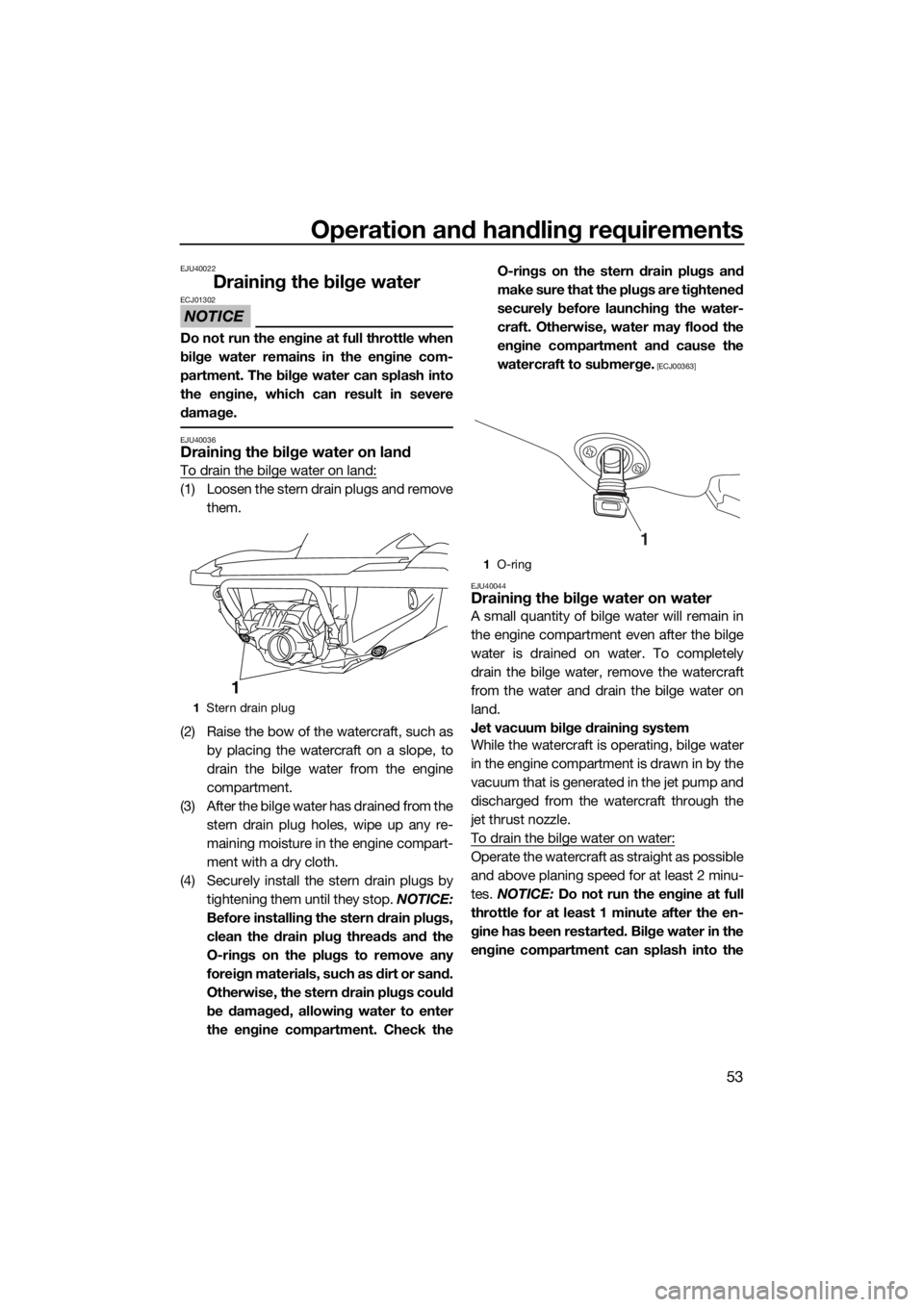
Operation and handling requirements
53
EJU40022
Draining the bilge water
NOTICE
ECJ01302
Do not run the engine at full throttle when
bilge water remains in the engine com-
partment. The bilge water can splash into
the engine, which can result in severe
damage.
EJU40036Draining the bilge water on land
To drain the bilge water on land:
(1) Loosen the stern drain plugs and remove
them.
(2) Raise the bow of the watercraft, such as
by placing the watercraft on a slope, to
drain the bilge water from the engine
compartment.
(3) After the bilge water has drained from the
stern drain plug holes, wipe up any re-
maining moisture in the engine compart-
ment with a dry cloth.
(4) Securely install the stern drain plugs by
tightening them until they stop. NOTICE:
Before installing the stern drain plugs,
clean the drain plug threads and the
O-rings on the plugs to remove any
foreign materials, such as dirt or sand.
Otherwise, the stern drain plugs could
be damaged, allowing water to enter
the engine compartment. Check theO-rings on the stern drain plugs and
make sure that the plugs are tightened
securely before launching the water-
craft. Otherwise, water may flood the
engine compartment and cause the
watercraft to submerge.
[ECJ00363]
EJU40044
Draining the bilge water on water
A small quantity of bilge water will remain in
the engine compartment even after the bilge
water is drained on water. To completely
drain the bilge water, remove the watercraft
from the water and drain the bilge water on
land.
Jet vacuum bilge draining system
While the watercraft is operating, bilge water
in the engine compartment is drawn in by the
vacuum that is generated in the jet pump and
discharged from the watercraft through the
jet thrust nozzle.
To drain the bilge water on water:
Operate the watercraft as straight as possible
and above planing speed for at least 2 minu-
tes. NOTICE: Do not run the engine at full
throttle for at least 1 minute after the en-
gine has been restarted. Bilge water in the
engine compartment can splash into the
1Stern drain plug
1
1O-ring
1
UF3K72E0.book Page 53 Thursday, July 16, 2015 2:31 PM
Page 60 of 106
![YAMAHA FZS SVHO 2016 Owners Manual Operation and handling requirements
54
engine, which can result in severe dam-
age.
[ECJ00554]
Electric bilge draining system
Bilge water in the engine compartment is
drawn in by the operation of the YAMAHA FZS SVHO 2016 Owners Manual Operation and handling requirements
54
engine, which can result in severe dam-
age.
[ECJ00554]
Electric bilge draining system
Bilge water in the engine compartment is
drawn in by the operation of the](/manual-img/51/50230/w960_50230-59.png)
Operation and handling requirements
54
engine, which can result in severe dam-
age.
[ECJ00554]
Electric bilge draining system
Bilge water in the engine compartment is
drawn in by the operation of the electric bilge
pump and discharged from the watercraft.
To check for proper operation of the electric
bilge draining system, make sure that bilge
water is being discharged from the electric
bilge pilot outlet.
To drain the bilge water:
Start the engine to operate the electric bilge
pump.
TIP:
The electric bilge pump continues to operate
for a short time after the engine stops.
EJU33465
Transporting on a trailer
When transporting the watercraft on a trailer,
secure the tie downs to the trailer through the
bow eye and stern eyes. NOTICE: Do not at-
tach ropes or tie downs to any part of the
watercraft other than the bow eye and
stern eyes to secure the watercraft to the
trailer. Otherwise, the watercraft may be
damaged. Wrap the ropes or tie downs
with towels or rags where they touch the
body of the watercraft to avoid scratches
or damage. Do not transport the water-
craft with the shift lever in the reverse po-
sition. Otherwise, the reverse gate may hit
an obstacle, which could cause damage.
[ECJ00645]
1Electric bilge pilot outlet
1
UF3K72E0.book Page 54 Thursday, July 16, 2015 2:31 PM
Page 62 of 106

Pre-operation checks
56
EJU31982
WARNING
EWJ00412
Failure to inspect or maintain the watercraft properly increases the possibility of an ac-
cident or damage to the watercraft. Do not operate the watercraft if you find any prob-
lem. If a problem cannot be corrected by the procedures provided in this manual, have
the watercraft inspected by a Yamaha dealer.
EJU41234Pre-operation checklist
Before using this watercraft, be sure to perform the checks in the following checklist.
ITEM ROUTINE PAGE
PRE-LAUNCH CHECKS
Engine compartmentVentilate the engine compartment.
Check inside the engine compartment for damage.58
Fuel systemCheck the fuel system for leakage.
Check the fuel level in the fuel tank.58
Water separatorCheck the water separator for water. 58
Engine unitCheck the exterior of the engine unit for damage. 59
Engine oil levelCheck the engine oil level. 59
Bilge waterCheck the engine compartment for bilge water. 59
BatteryCheck the battery connections and electrolyte level. 59
Steering systemCheck the steering system for proper operation. 60
Telescopic steering systemCheck the telescopic steering system for proper op-
eration and check that the handlebars are securely
locked in place.61
Q.S.T.S.Check the Q.S.T.S. for proper operation and check
that the Q.S.T.S. selector is securely locked in pla-
ce.61
Reverse systemCheck the reverse system for proper operation. 62
Throttle leverCheck the throttle lever for proper operation.
Check the throttle lever free play.62
Remote control transmitterCheck the remote control transmitter for proper op-
eration.63
Engine shut-off cord (lan-
yard)Check the engine shut-off cord (lanyard) for dam-
age.63
SwitchesCheck the start switch, engine stop switch, and en-
gine shut-off switch for proper operation.63
Storage compartmentsCheck the storage compartments for damage and
water.64
Fire extinguisher holder,
cover, and bandCheck the fire extinguisher holder, cover, and band
for damage.64
Fire extinguisherCheck the condition of the fire extinguisher. 64
UF3K72E0.book Page 56 Thursday, July 16, 2015 2:31 PM
Page 69 of 106
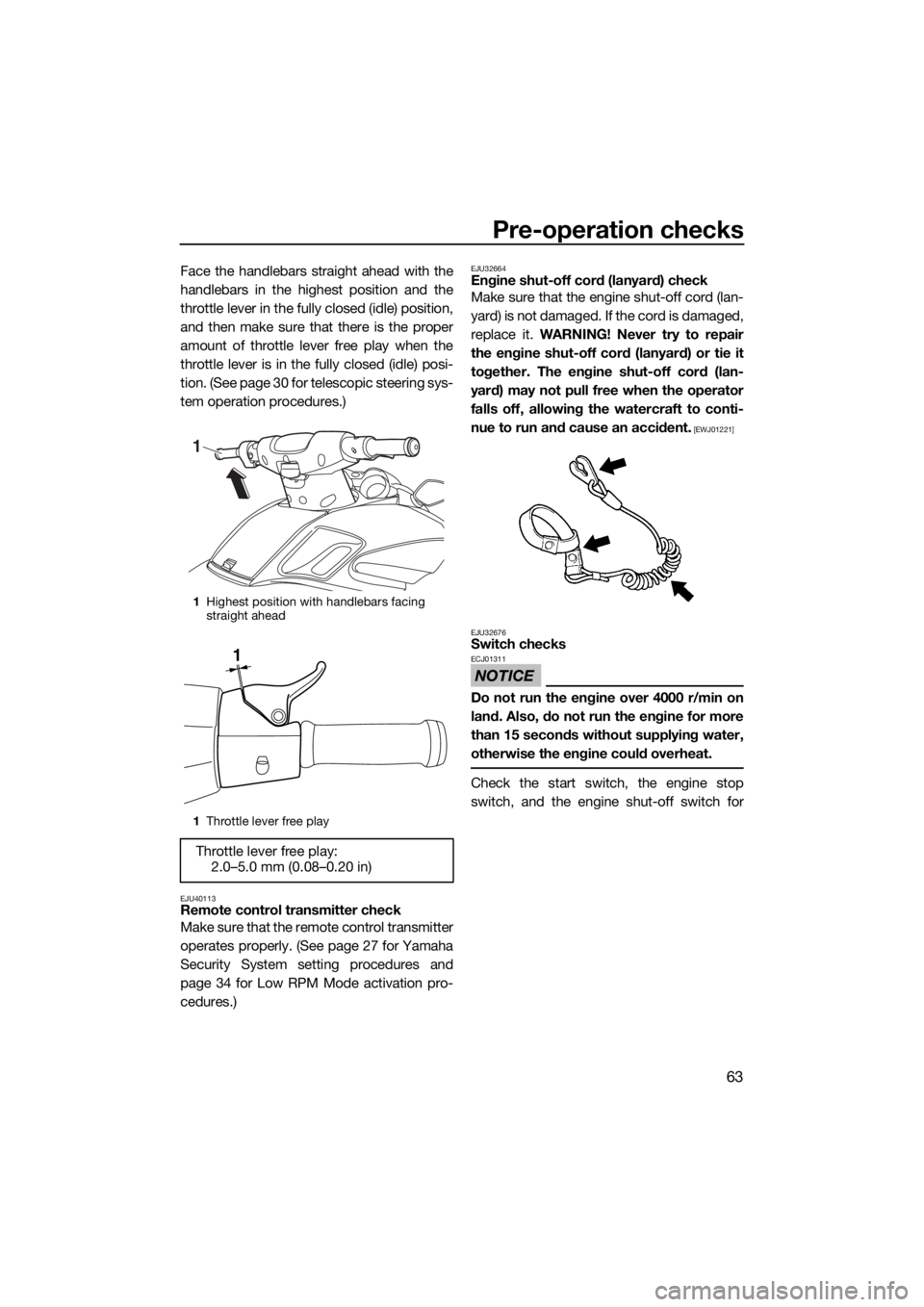
Pre-operation checks
63
Face the handlebars straight ahead with the
handlebars in the highest position and the
throttle lever in the fully closed (idle) position,
and then make sure that there is the proper
amount of throttle lever free play when the
throttle lever is in the fully closed (idle) posi-
tion. (See page 30 for telescopic steering sys-
tem operation procedures.)
EJU40113Remote control transmitter check
Make sure that the remote control transmitter
operates properly. (See page 27 for Yamaha
Security System setting procedures and
page 34 for Low RPM Mode activation pro-
cedures.)
EJU32664Engine shut-off cord (lanyard) check
Make sure that the engine shut-off cord (lan-
yard) is not damaged. If the cord is damaged,
replace it. WARNING! Never try to repair
the engine shut-off cord (lanyard) or tie it
together. The engine shut-off cord (lan-
yard) may not pull free when the operator
falls off, allowing the watercraft to conti-
nue to run and cause an accident.
[EWJ01221]
EJU32676
Switch checks
NOTICE
ECJ01311
Do not run the engine over 4000 r/min on
land. Also, do not run the engine for more
than 15 seconds without supplying water,
otherwise the engine could overheat.
Check the start switch, the engine stop
switch, and the engine shut-off switch for
1Highest position with handlebars facing
straight ahead
1Throttle lever free play
Throttle lever free play:
2.0–5.0 mm (0.08–0.20 in)
1
1
UF3K72E0.book Page 63 Thursday, July 16, 2015 2:31 PM
Page 70 of 106
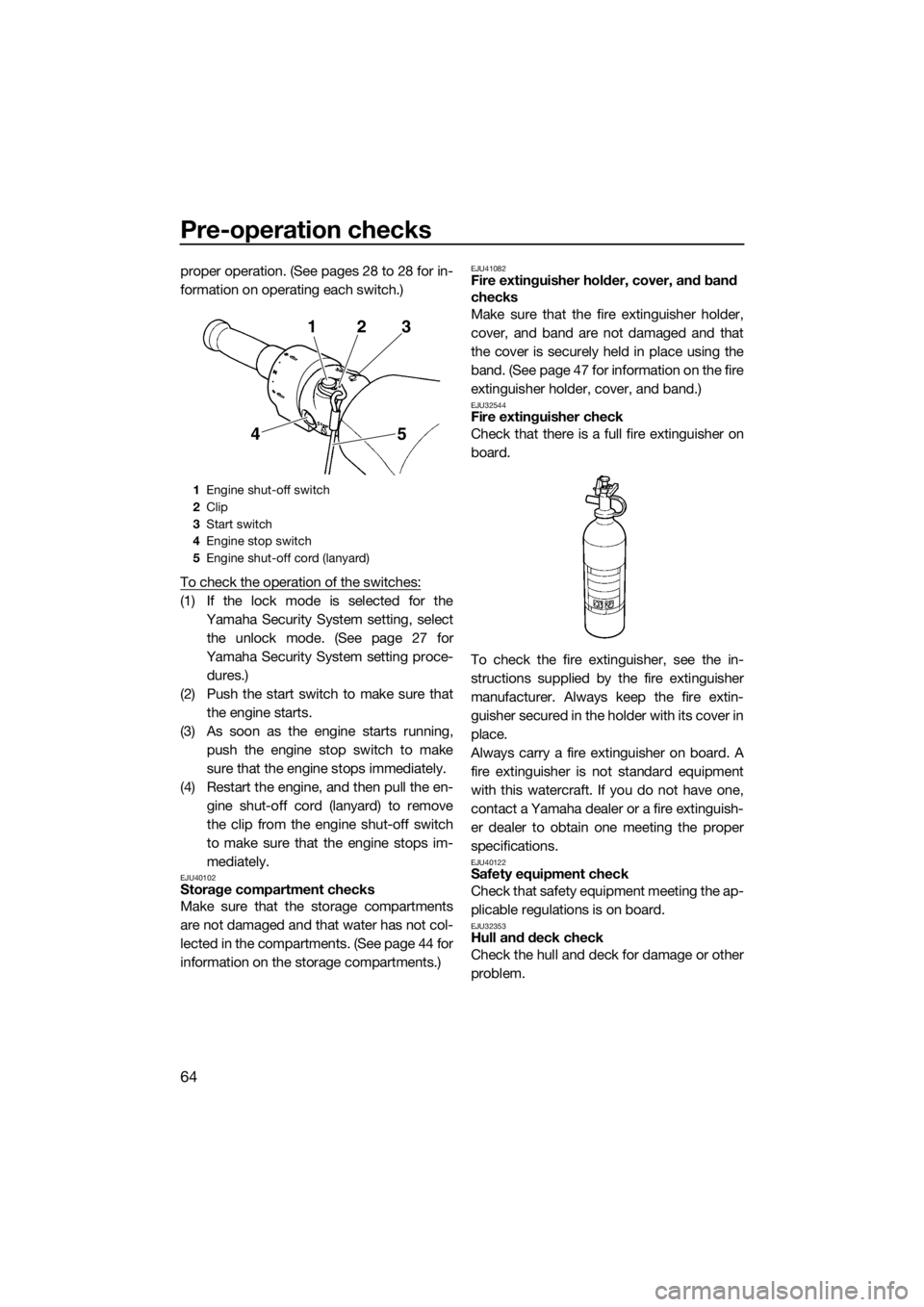
Pre-operation checks
64
proper operation. (See pages 28 to 28 for in-
formation on operating each switch.)
To check the operation of the switches:
(1) If the lock mode is selected for the
Yamaha Security System setting, select
the unlock mode. (See page 27 for
Yamaha Security System setting proce-
dures.)
(2) Push the start switch to make sure that
the engine starts.
(3) As soon as the engine starts running,
push the engine stop switch to make
sure that the engine stops immediately.
(4) Restart the engine, and then pull the en-
gine shut-off cord (lanyard) to remove
the clip from the engine shut-off switch
to make sure that the engine stops im-
mediately.
EJU40102Storage compartment checks
Make sure that the storage compartments
are not damaged and that water has not col-
lected in the compartments. (See page 44 for
information on the storage compartments.)
EJU41082Fire extinguisher holder, cover, and band
checks
Make sure that the fire extinguisher holder,
cover, and band are not damaged and that
the cover is securely held in place using the
band. (See page 47 for information on the fire
extinguisher holder, cover, and band.)
EJU32544Fire extinguisher check
Check that there is a full fire extinguisher on
board.
To check the fire extinguisher, see the in-
structions supplied by the fire extinguisher
manufacturer. Always keep the fire extin-
guisher secured in the holder with its cover in
place.
Always carry a fire extinguisher on board. A
fire extinguisher is not standard equipment
with this watercraft. If you do not have one,
contact a Yamaha dealer or a fire extinguish-
er dealer to obtain one meeting the proper
specifications.
EJU40122Safety equipment check
Check that safety equipment meeting the ap-
plicable regulations is on board.
EJU32353Hull and deck check
Check the hull and deck for damage or other
problem.
1Engine shut-off switch
2Clip
3Start switch
4Engine stop switch
5Engine shut-off cord (lanyard)
23 1
5 4
UF3K72E0.book Page 64 Thursday, July 16, 2015 2:31 PM
Page 75 of 106
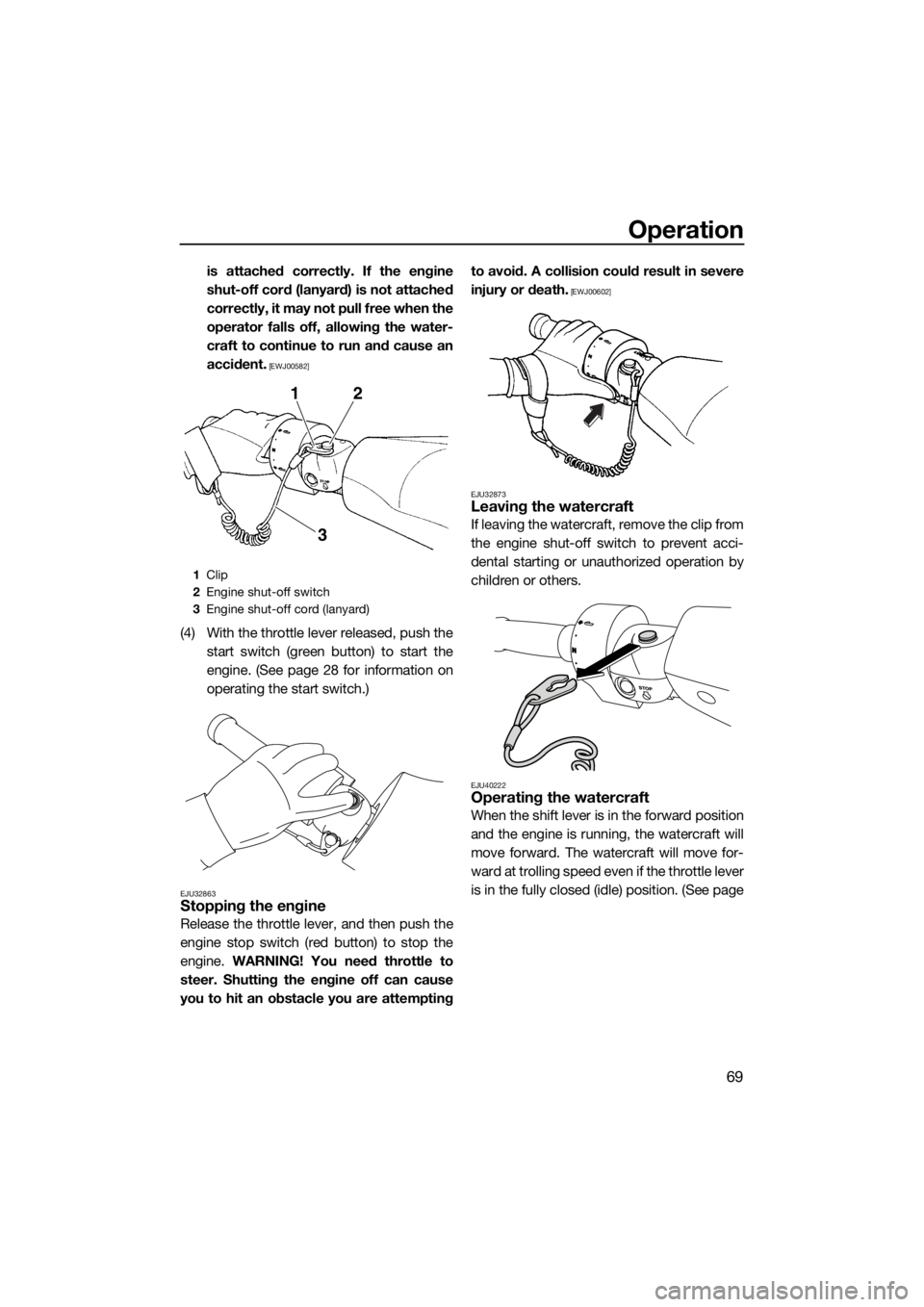
Operation
69
is attached correctly. If the engine
shut-off cord (lanyard) is not attached
correctly, it may not pull free when the
operator falls off, allowing the water-
craft to continue to run and cause an
accident.
[EWJ00582]
(4) With the throttle lever released, push the
start switch (green button) to start the
engine. (See page 28 for information on
operating the start switch.)
EJU32863Stopping the engine
Release the throttle lever, and then push the
engine stop switch (red button) to stop the
engine. WARNING! You need throttle to
steer. Shutting the engine off can cause
you to hit an obstacle you are attemptingto avoid. A collision could result in severe
injury or death.
[EWJ00602]
EJU32873
Leaving the watercraft
If leaving the watercraft, remove the clip from
the engine shut-off switch to prevent acci-
dental starting or unauthorized operation by
children or others.
EJU40222Operating the watercraft
When the shift lever is in the forward position
and the engine is running, the watercraft will
move forward. The watercraft will move for-
ward at trolling speed even if the throttle lever
is in the fully closed (idle) position. (See page
1Clip
2Engine shut-off switch
3Engine shut-off cord (lanyard)
12
3
UF3K72E0.book Page 69 Thursday, July 16, 2015 2:31 PM
Page 83 of 106
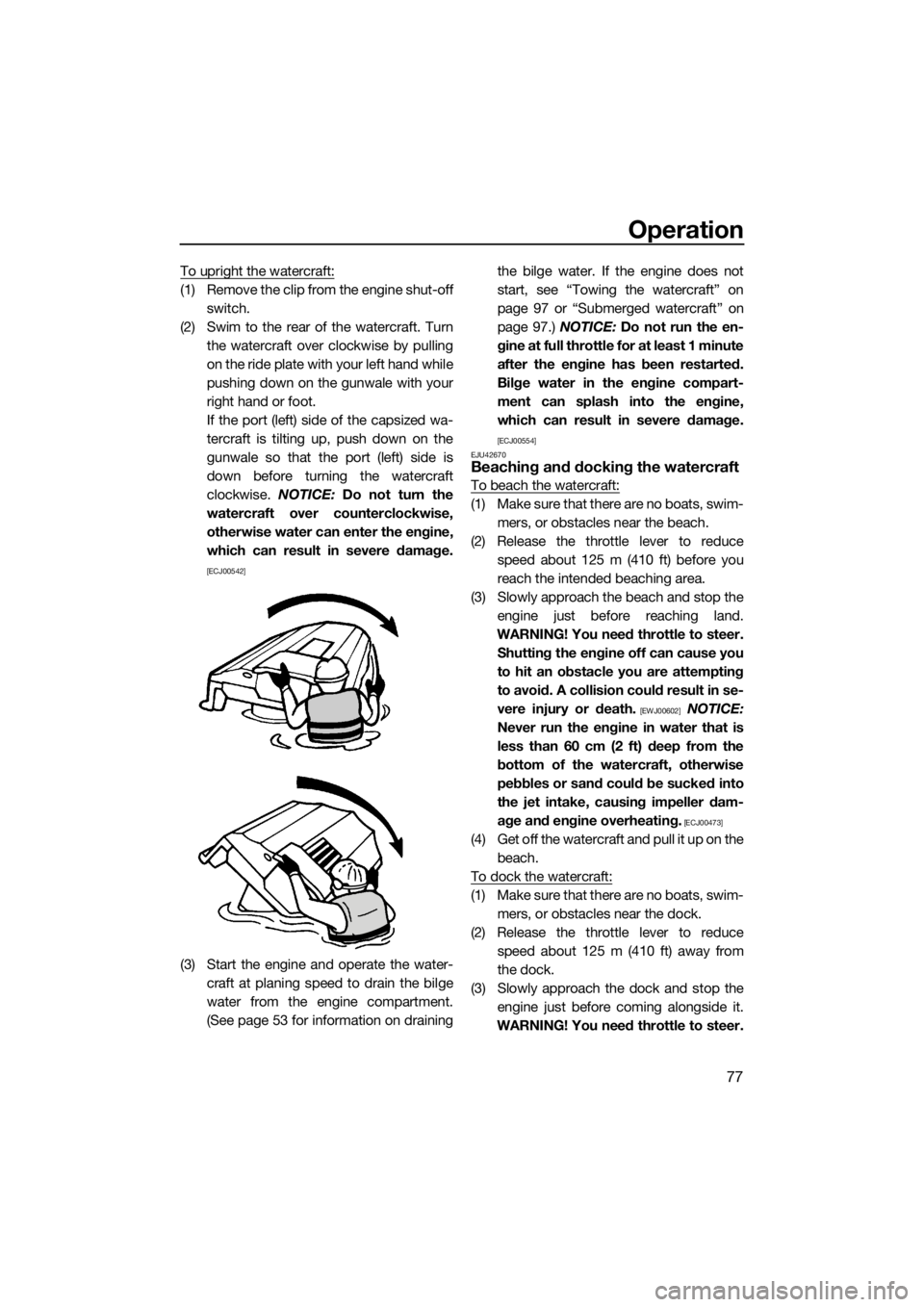
Operation
77
To upright the watercraft:
(1) Remove the clip from the engine shut-off
switch.
(2) Swim to the rear of the watercraft. Turn
the watercraft over clockwise by pulling
on the ride plate with your left hand while
pushing down on the gunwale with your
right hand or foot.
If the port (left) side of the capsized wa-
tercraft is tilting up, push down on the
gunwale so that the port (left) side is
down before turning the watercraft
clockwise. NOTICE: Do not turn the
watercraft over counterclockwise,
otherwise water can enter the engine,
which can result in severe damage.
[ECJ00542]
(3) Start the engine and operate the water-
craft at planing speed to drain the bilge
water from the engine compartment.
(See page 53 for information on drainingthe bilge water. If the engine does not
start, see “Towing the watercraft” on
page 97 or “Submerged watercraft” on
page 97.) NOTICE: Do not run the en-
gine at full throttle for at least 1 minute
after the engine has been restarted.
Bilge water in the engine compart-
ment can splash into the engine,
which can result in severe damage.
[ECJ00554]
EJU42670
Beaching and docking the watercraft
To beach the watercraft:
(1) Make sure that there are no boats, swim-
mers, or obstacles near the beach.
(2) Release the throttle lever to reduce
speed about 125 m (410 ft) before you
reach the intended beaching area.
(3) Slowly approach the beach and stop the
engine just before reaching land.
WARNING! You need throttle to steer.
Shutting the engine off can cause you
to hit an obstacle you are attempting
to avoid. A collision could result in se-
vere injury or death.
[EWJ00602] NOTICE:
Never run the engine in water that is
less than 60 cm (2 ft) deep from the
bottom of the watercraft, otherwise
pebbles or sand could be sucked into
the jet intake, causing impeller dam-
age and engine overheating.
[ECJ00473]
( 4 ) G e t o f f t h e w a t e r c r a f t a n d p u l l i t u p o n t h e
beach.
To dock the watercraft:
(1) Make sure that there are no boats, swim-
mers, or obstacles near the dock.
(2) Release the throttle lever to reduce
speed about 125 m (410 ft) away from
the dock.
(3) Slowly approach the dock and stop the
engine just before coming alongside it.
WARNING! You need throttle to steer.
UF3K72E0.book Page 77 Thursday, July 16, 2015 2:31 PM